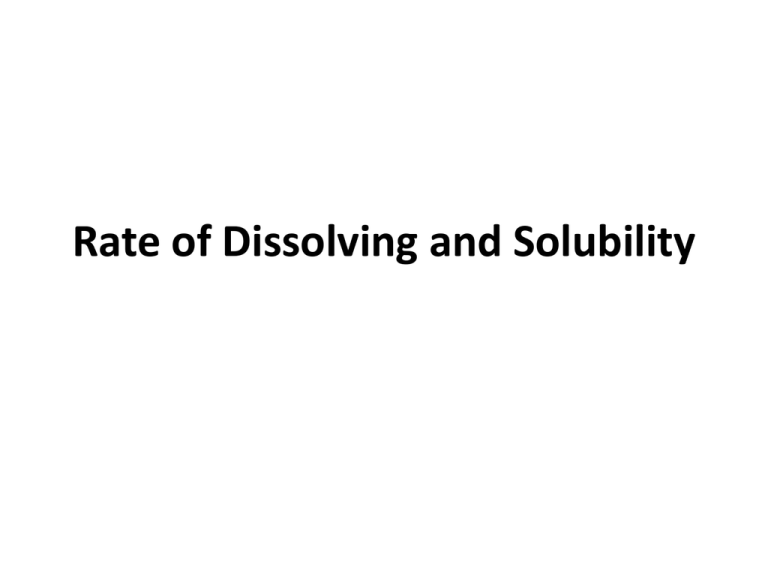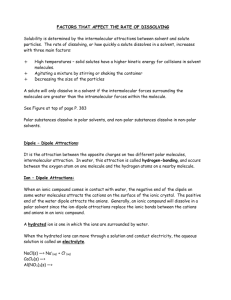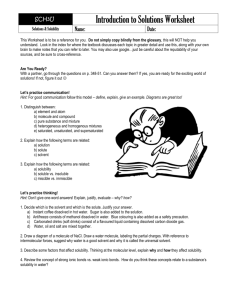Solubility increases with Temperature
advertisement

Rate of Dissolving and Solubility Chemistry Literature Connection • “Water does not resist. Water flows. When you plunge your hand into it, all you feel is a caress. Water is not a solid wall, it will not stop you. But water always goes where it wants to go, and nothing in the end can stand against it. Water is patient. Dripping water wears away a stone. Remember that, my child. Remember you are half water. If you can't go through an obstacle, go around it. Water does.” ― Margaret Atwood, The Penelopiad Explaining Solutions • Why are some substances soluble and some not? Why do only some chemicals dissolved in water? • For Ionic Compounds – the solvents ability to ‘break’ ionic bonds determines their solubility. • In covalent compounds a solute’s ability to dissolve in a solvent is dependent on the potential intermolecular forces (DDF, LDF, H-Bonding) that can occur between them. Let’s Review Intra & Intermolecular Forces… Intramolecular Forces: – The attractive forces between atoms and ions within a molecule • e.g Ionic bond, covalent bonds (e.g. polar, nonpolar, double, triple) • Relatively strong Intermolecular Forces: – The attractive forces between molecules • E.g. Van der Waals forces: London dispersion forces, dipole-dipole forces, hydrogen bonds • Weak (in comparison to intramolecular forces) • I.e. much less energy to melt H2O (inter) than for it to decompose into H2 and O2 (intra) London Dispersion • Attractive forces between all molecules, including nonpolar molecules • Result of temporary displacements of the electron cloud around atoms in a molecule (extremely shortlived dipoles) • Therefore weaker than dipoledipole Hydrogen Bonding H-bond • Strong dipole-dipole force between the positive hydrogen atom of one molecule and highly electronegative atom of another molecule (O, N, F) Discussion/Recap: • Rank the intermolecular forces from weakest to strongest. • How might intermolecular forces affect physical state? • How might intermolecular forces affect melting point? • So WHY do some substances (solutes) dissolve to form solutions but others don’t? – All comes down to POLARITY • General rule of thumb – like dissolves like – Polar solvents will dissolve polar solutes. – Non-polar solvents will dissolve non-polar solutes Polarity of Water Molecules Electronegativity difference O = 3.5 H = 2.1 3.5 – 2.1 = 1.4 Recall: between 0.5 and 1.6 = bond is polar covalent Polarity of Water Molecules Dipole moment =measure the polarity of a chemical bond, occurs whenever there is a separation of positive and negative charges Ionic Compounds in Water Ionic Compounds in Water Polar Molecules in Water Hydrogen Bonding Polar Molecules (Sugar) in Water Polar Molecules (Sugar) in Water Non-Polar Molecules in Water Learning Check: Is it Soluble? Why or Why Not? ① ammonia in water ① Water in hexane ② Carbon tetrachloride in hexane Dissociation • Water is known as the “universal solvent” – WHY? – Both DDF and H-Bonding occurs in water, so it is able to ‘dissolve’ a number of solutes • (plus it is really small) • Ionic Compounds will dissociate in polar solvents (not dissolve) to form their ions because they are able to form ion-dipole bonds. (slide 11 & 12) – Need to break ionic bonds to ‘dissociate a salt – Eg. NaCl(s) Na+(aq) + Cl-(aq) – We write dissociation equations to represent dissociation of ionic compounds in aqueous solution. THE ‘DISSOLVING’ OF IONIC CMPDS Hydration – the process where ions are surrounded by water molecules Writing Dissociation Equations • Write equations to represent the dissociation of the following ionic compounds in aqueous solution: – Sodium fluoride – Aluminum sulphate – Cobalt (II) chloride hexahydrate Some Terms to Remember… • Electrolyte = a compound that in an aqueous solution conducts electricity – Mosty ionic compounds • Nonelectrolyte = a compound that, in an aqueous solution, does not conduct electricity – Mostly molecular compounds THE DISSOLVING OF MOLECULAR CPDS MISCIBLE compounds are able to mix easily to form a solution (ex. glucose) IMMISCIBLE compounds are unable to mix to form a solution (ex. oil) Remember – ‘Like Dissolves Like’ for polar and non-polar substances Involves Hydrogen Bonding Dissolving Process ① Separation of Solute – must overcome IMF or ion-ion attractions in solute – requires energy, ENDOTHERMIC ( + DH) ② Separation of Solvent – must overcome IMF of solvent particles – requires energy, ENDOTHERMIC (+ DH) ③ Interaction of Solute & Solvent – attractive bonds form between solute particles and solvent particles – “Solvation” or “Hydration” (where water = solvent) – releases energy, EXOTHERMIC (- DH) Rate of Dissolving Increases with: ① Agitation • Brings solvent in contact with solute • Stirring, shaking or swirling ② Increased temperature • Kinetic Molecular Theory ③ Particle size • Surface Area • Ex: crushing a solid using a mortar and pestle Factors Affecting Solubility • Solubility - measures how much solute dissolves in a given volume of solvent, at a specific temperature, to form a saturated solution. – Depends on molecule size, temperature and pressure. • Let’s do a lab…. Factors Affecting Solubility 1. Nature of Solute / Solvent. - Like dissolves like intermolecular forces (IMF), size of particles 2. Temperature – i. Solids/Liquids- Solubility increases with Temperature Increase kinetic energy (K.E.) increases motion and collision between solute / solvent. ii) gas - Solubility decreases with Temperature Increase K.E. result in gas escaping to atmosphere. 3. Pressure Factor i) Solids/Liquids - Very little effect Solids and Liquids are already close together, extra pressure will not increase solubility. ii) gas - Solubility increases with Pressure. Increase pressure squeezes gas solute into solvent. Solubility Curves of several 1.Solubilities Comparing KI and KCl, ionic solid is asmore a function of at 10 which soluble oC? temperature. MOST salts 2.have How much KI would greater solubility in hotdissolve water. in 100 g of water at 10 oC? 3.A few How much would salts haveKInegative dissolve in 25 g of water at heat ofo solution, 10 C? (exothermic process) and 4. A chemist prepares a theysolution becomecontaining less soluble45 g of withNaNO increasing 100 g of water 20 3 in oC. Is the solution temperature. saturated? Solubility curve learning check • What mass of solute will dissolve in 100mL of water at the following temperatures. Also determine which of the three substances is most soluble in water at 15°C. • 1.KNO3at 70°C • 2.NaCl at 100°C • 3.NH4Cl at 90°C Solution: Solubility 1.KNO3at 70°C is 138g / 100mL 2.NaCl at 100°C is 38g / 100mL 3.NH4Cl at 90°Cis 72g / 100mL 4.NaCl is the most soluble at 15°C Remember the Degrees of Saturation? GENERAL TREND: Solubility curve learning check cont’d 1. What term - saturated, unsaturated, or supersaturated - best describes: • a solution that contains 70g of NaNO3 per 100 mL H2O at 30°C • a solution that contains 60g of dissolved KCl per 100 mL H2O at 80°C Solution • The NaNO3 solution is unsaturated. At 30°C a saturated solution would be able to dissolve approximately 95 g of NaNO3 . Since there are only 70g in the solution, 25 more grams of NaNO3 could be added and it would all dissolve. • The KCl solution is supersaturated. At 80°C a saturated KCl solution contains 50 g KCl per 100 mL H2O. This solution is holding 10 g of excess KCl. • If a small crystal of KCl is added to this supersaturated solution, the excess KCl will immediately come out of solution. Temperature & the Solubility of Gases The solubility of gases DECREASES at higher temperatures HOMEWORK: Here’s a funny… A physicist, a biologist, and a chemist went to the ocean for the first time. The physicist was fascinated and wanted to study the fluid dynamics of the waves. He walked into the ocean and never returned. The biologist decided to study the flora and fauna. She walked into the ocean and never returned. The chemist waited for a long time. Finally he wrote down his observation, "Physicists and biologists are soluble in ocean water."






